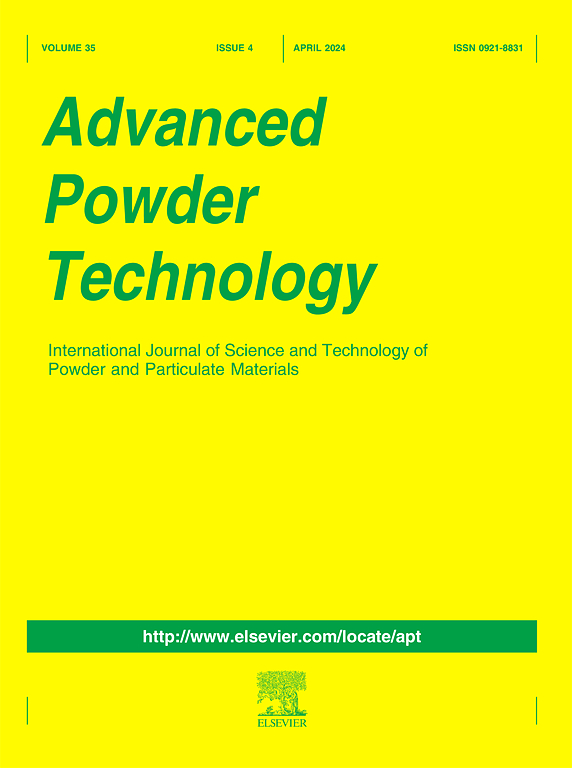Synthesis of spherical particles of ceria-zirconia solid solution by microwave-emulsion method
IF 4.2
2区 工程技术
Q2 ENGINEERING, CHEMICAL
引用次数: 0
Abstract
Microwave-emulsion method has been explored for synthesis of spherical oxide particles with combination of rapid and selective heating by microwave and spherical shape control by emulsion method. The CeO2-ZrO2 solid solution particles were prepared by heating of W/O emulsions under microwave irradiation followed by calcination. Oil phase was n-hexane including tetraglycerin condensed ricinolate and polysorbate 80 as emulsifier, and water phase included (NH4)2Ce(NO3)6 and ZrOCl2 as metal source and (NH4)2C4H4O6 as hydrolysis agent. As-produced powder exhibited cubic phase at Ce/Zr ≥ 5/5 and amorphous phase at Ce/Zr ≤ 3/7. After calcination, the lattice constant of cubic CeO2 decreased and tetragonal and monoclinic phases of ZrO2 appeared at large Zr content. Pure CeO2 was agglomerates of fine particles and spherical particles with a size of 0.5–1 μm were obtained by addition of ZrO2, indicating that the spherical particles were the mixture of crystalline CeO2 and amorphous ZrO2. The oxygen storage capacity increased with rising calcination temperature due to the formation of solid solution but decreased at high temperature due to decrease in surface area.

微波乳化法制备球形二氧化锆固溶体
采用微波快速选择性加热和乳化法球形控制相结合的方法,探索了微波-乳化法合成球形氧化物颗粒的方法。采用微波加热W/O乳剂,煅烧法制备了CeO2-ZrO2固溶体颗粒。油相为正己烷(含四甘油缩合蓖麻酸酯和聚山梨酸酯80)为乳化剂,水相为(NH4)2Ce(NO3)6和ZrOCl2为金属源,(NH4)2C4H4O6为水解剂。Ce/Zr≥5/5时为立方相,Ce/Zr≤3/7时为非晶相。煅烧后,立方CeO2的晶格常数降低,Zr含量大时出现了ZrO2的四方相和单斜相。纯CeO2为细颗粒的团聚体,ZrO2的加入可获得0.5 ~ 1 μm的球形颗粒,表明球形颗粒是结晶型CeO2和非晶型ZrO2的混合物。随着煅烧温度的升高,储氧容量随着固溶体的形成而增大,但随着煅烧温度的升高,储氧容量随着表面积的减小而减小。
本文章由计算机程序翻译,如有差异,请以英文原文为准。
求助全文
约1分钟内获得全文
求助全文
来源期刊

Advanced Powder Technology
工程技术-工程:化工
CiteScore
9.50
自引率
7.70%
发文量
424
审稿时长
55 days
期刊介绍:
The aim of Advanced Powder Technology is to meet the demand for an international journal that integrates all aspects of science and technology research on powder and particulate materials. The journal fulfills this purpose by publishing original research papers, rapid communications, reviews, and translated articles by prominent researchers worldwide.
The editorial work of Advanced Powder Technology, which was founded as the International Journal of the Society of Powder Technology, Japan, is now shared by distinguished board members, who operate in a unique framework designed to respond to the increasing global demand for articles on not only powder and particles, but also on various materials produced from them.
Advanced Powder Technology covers various areas, but a discussion of powder and particles is required in articles. Topics include: Production of powder and particulate materials in gases and liquids(nanoparticles, fine ceramics, pharmaceuticals, novel functional materials, etc.); Aerosol and colloidal processing; Powder and particle characterization; Dynamics and phenomena; Calculation and simulation (CFD, DEM, Monte Carlo method, population balance, etc.); Measurement and control of powder processes; Particle modification; Comminution; Powder handling and operations (storage, transport, granulation, separation, fluidization, etc.)
 求助内容:
求助内容: 应助结果提醒方式:
应助结果提醒方式:


